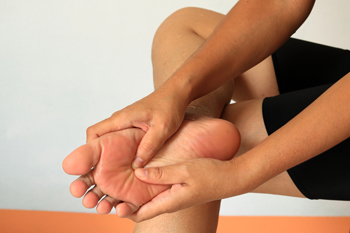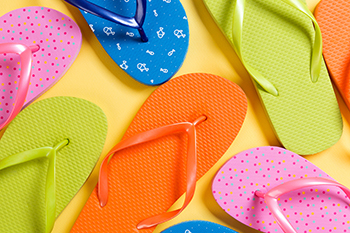Dr. Kennan T. Runte, DPM, FACFAS
Grass Valley, CA 95945

Anyone who experiences pain in the ball of the foot, knows how it can affect the quality of life. This condition, known as metatarsalgia, is often the result of too much running, calluses under the midfoot, or a bunion or other malformation that throws off the gait. These can result in increased pressure on the metatarsals (the long bones of the foot that connect the toe and ankle bones). They become bruised and sore. One way to help ease the pain is bathe your foot in epsom salts and warm water for ten to twelve minutes. Another is to ice the area, being sure to cover the foot before applying an ice pack. Other self-help methods are to treat yourself to a foot massage and embark on a regime of simple foot exercises. One very important way to reduce metatarsal pain is to stop doing things that contribute to it or make it worse. Give up the high-heeled and pointy-toed shoes, because they not only force more pressure onto the ball of the foot, but also can cause a number of other foot maladies, such as bunions, hammertoes, corns or calluses, to develop. If the pain in the ball of your foot continues, or worsens, it is suggested that you see a podiatrist who can diagnose the specific problem and inform you of further treatment options.
Foot Pain
Foot pain can be extremely painful and debilitating. If you have a foot pain, consult with one of our podiatrists from Foothill Podiatry Clinic. Our doctors will assess your condition and provide you with quality foot and ankle treatment.
Causes
Foot pain is a very broad condition that could be caused by one or more ailments. The most common include:
Diagnosis
To figure out the cause of foot pain, podiatrists utilize several different methods. This can range from simple visual inspections and sensation tests to X-rays and MRI scans. Prior medical history, family medical history, and any recent physical traumatic events will all be taken into consideration for a proper diagnosis.
Treatment
Treatment depends upon the cause of the foot pain. Whether it is resting, staying off the foot, or having surgery; podiatrists have a number of treatment options available for foot pain.
If you have any questions, please feel free to contact our office located in Grass Valley, CA . We offer the newest diagnostic and treatment technologies for all your foot care needs.
Although it may be tempting to wear flip-flops in warm weather, they are not the best choice of footwear for your feet. Flip-flops may be ideal for the beach, pool, spa, and shared showers, but you should avoid wearing them unless it is completely necessary.
Flip-flops only have a small strip of fabric holding your foot in place, but your toes need a better grip to keep your foot in place. The repetitive gripping can lead to an overuse of your muscles, which could result in tendinitis. This is only one of the many problems that stem from wearing flip-flops too often.
Flip flops aren’t good for extensive walking because they fail to offer arch support, heel cushioning, or shock absorption. As a result, people who wear flip flops are at a higher risk of experiencing an ankle sprain. Additionally, these shoes offer little protection for your feet, putting those who wear them at a greater risk for stubbed toes, glass cuts, and puncture wounds.
Although flip flops aren’t recommended for everyday use by anyone, it is especially important for diabetics to avoid them. A diabetic foot injury can easily become very serious, and it may even lead to amputation.
If you are experiencing pain from wearing flip-flops, you shouldn’t be hesitant to replace them with a more comfortable shoe that offers more support. If your flip-flop foot pain doesn’t go away, you should seek assistance from a podiatrist right away. It is possible that you may have a more serious foot problem such as a stress fracture or arthritis.

Flip flops are considered to be the official shoe of summer. They are made from a flat rubber sole with a Y-shaped strap that that fits between the big and second toe. They are known to offer minimal, if no support, and, when frequently worn can cause foot conditions to develop. Among them are chronic heel pain and cracked heels. In addition, the walking style, or gait, may be negatively affected, and the toes may become fatigued from constantly gripping the top of the shoe to keep the foot in the shoe and in place. Some patients develop an Achilles tendon injury as a result of added pressure put on the calf muscles. It is suggested that people who enjoy wearing flip flops choose a pair with a thicker heel, which may alleviate some of the pressure on the overall foot. If you need to know more about how flip flops can affect the feet, it is advised that you confer with a podiatrist.
Flip-flops can cause a lot of problems for your feet. If you have any concerns about your feet or ankles, contact one of our podiatrists from Foothill Podiatry Clinic. Our doctors will assist you with all of your foot and ankle needs.
Flip-Flops and Feet
Flip-flops have managed to become a summer essential for a lot of people. While the shoes may be stylish and easy to slip on and off, they can be dangerous to those who wear them too often. These shoes might protect you from fungal infections such as athlete’s foot, but they can also give you foot pain and sprained ankles if you trip while wearing them.
When Are They Okay to Wear?
Flip-flops should only be worn for very short periods of time. They can help protect your feet in places that are crawling with fungi, such as gym locker rooms. Athlete’s foot and plantar warts are two common fungi that flip-flops may help protect your feet against.
Why Are They Bad for My Feet?
These shoes do not offer any arch support, so they are not ideal for everyday use. They also do not provide shock absorption or heel cushioning which can be problematic for your feet. Additionally, you may suffer from glass cuts, puncture wounds, and stubbed toes since they offer little protection for your feet.
More Reasons Why They Are Bad for Your Feet
If you have any questions, please feel free to contact our office located in Grass Valley, CA . We offer the newest diagnostic and treatment technologies for all your foot care needs.